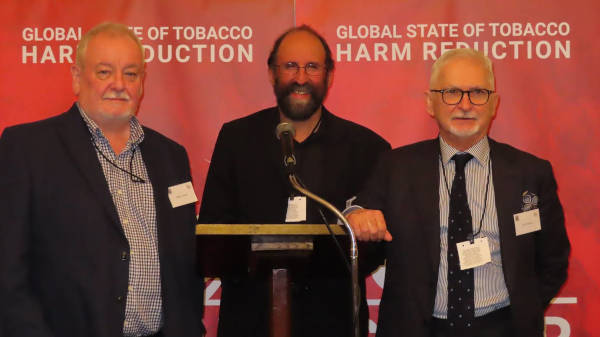A report by Knowledge-Action-Change explains the advantages of embracing harm reduction to help tackle the global smoking epidemic.
By George Gay
The existence of 101 countries that have no specific laws covering electronic cigarettes was reason enough to welcome the launch last year of a major report on tobacco harm reduction and the announcement that the report is to be taken on an international roadshow this year. And the existence of 62 countries that regulate e-cigarettes under tobacco legislation and 39 countries that have banned the sale of e-cigarettes and/or nicotine-containing e-liquids lends urgency to the roadshow.
While tobacco smoking is generally considered to be a major cause of preventable deaths, the use of the products described in the report, which have been shown to be acceptable substitutes for combustible cigarettes, is far less risky than smoking. So while it is bad enough that many smokers become ill and eventually die from indulging in their habit, they should not be condemned to suffer in this way because of ignorance about the existence of alternative products. Or perhaps that should read “condemned by the ignorance of regulators”—in 14 countries, e-cigarettes are banned but are widely available, suggesting that ordinary people are sometimes better informed than regulators.
No Fire, No Smoke: The Global State of Tobacco Harm Reduction 2018 was undertaken by Knowledge-Action-Change (KAC), a private sector public health agency, and supported solely by a grant from the Foundation for a Smoke-Free World1. It was written by Harry Shapiro, a KAC consultant.
The report, which is more than 120 pages long, is said to be the first to map the global, regional, and national availability and use of safer nicotine products, the regulatory responses to these products, and the public health potential of tobacco harm reduction. It has an introductory chapter on tobacco harm reduction as well as others on the continuing global epidemic of cigarette smoking; safer nicotine products; consumers of safer nicotine products; safer nicotine products and consumer health; regulation and control; and human rights, public health and tobacco harm reduction advocacy. In addition, tucked away in the back is a useful “vaping timeline” that journeys from 1927, though it is important to stress that the report, while focused on vapor devices, also looks at other lower-risk products such as snus.
In conclusion, Shapiro describes the report as an attempt to enumerate and explain the advantages of embracing harm reduction as a legitimate approach to help tackle the global smoking epidemic. “Apart from being founded on the well-established principles of the right to health for the world’s citizens, as enshrined in many international documents, it is also grounded in evidence-based pragmatism,” he says.
Shapiro goes on to say that those seeking harm reduction should not be distracted by concerns about “gateway” effects or “renormalizing” smoking, for which there was no robust evidence. He also says that people should not be overly swayed by talk of nicotine “addiction,” a word freighted with the worst images of serious and chaotic drug and alcohol use that do not apply to nicotine.
And he adds that it is important to focus on the prize—the end of traditional smoking—and not allow over-prescriptive regulation and control to deny access to products that have the potential to be one of the most dramatic public health coups of modern times—a coup that costs governments, international agencies and nongovernmental organizations nothing.
This last point is worth emphasizing because it underlines possibly the most vital aspect of the report and the roadshow: their potential to influence regulators and those in tobacco control who are so far uncommitted to tobacco harm reduction but are receptive to it. Consumers understood from the outset that e-cigarettes offer a less-risky way to consume nicotine, and they were willing to pay to enjoy this substitute activity. One of the few things that have held them back is the seemingly malicious intervention of reactionary elements within tobacco control hostile to the concept of tobacco harm reduction and the acquiescence of ill-informed regulators to their regressive “quit or die” message. More than anything, the tobacco harm reduction message needs to be spread as widely as possible so that it builds unstoppable momentum.
The report, which can be downloaded free of charge, was launched unofficially in Geneva, Switzerland, in October 2018, when it was given out to any participants approaching the World Health Organization’s Conference of the Parties (COP8) to the Framework Convention on Tobacco Control who were open-minded enough to take one. What the participants did with the report is anybody’s guess, but it is understood that only one report was hurled back at those handing them out, which must be a positive sign.
It was launched in the U.K. at an event hosted and addressed by viscount Matt Ridley at the Palace of Westminster on Dec. 18, 2018. And it is due to be taken on the road early this year. Professor Gerry Stimson, a director of KAC who, together with fellow director Paddy Costall, project managed the report, said the report would be taken to “key” countries, perhaps including Australia and India—so into the lion’s den. The roadshow stops would involve daylong tobacco harm reduction events based on the report but also including local advocates, Stimson said.
Because, we are told, a person dies from a smoking-related disease every six seconds, the report and the roadshow are vital undertakings. And for this reason, it is to be hoped that funding is forthcoming to keep the momentum of this project going in the coming years—at least until every smoker of combustible cigarettes has had the opportunity to learn the truth about alternative products. To learn, as the report says, that “quit or die” is no longer the only option for those who cannot give up nicotine, that safer nicotine products, including e-cigarettes, heat-not-burn products and Swedish snus, offer another way: “quit or try.”

George Gay
- The report’s acknowledgements include a note that the Foundation for a Smoke-Free World played no part in determining the content, analysis or conclusions in the report and that it provided input only at the initial concept stage. [↩]

